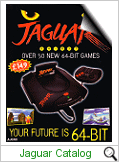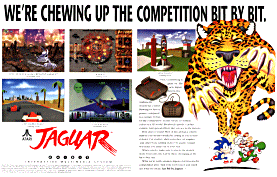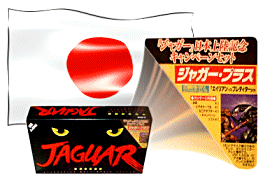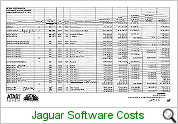|

It was the worlds first
64-Bit gaming console. It promised a quantum-leap in gaming
performance, and the world couldn't wait to get hold of one. Atari
was back with its first new console since the Atari 7800 which had been
released in 1984, could the company really take back the market it gave
birth too?
Jaguar was officially
launched in New York and San Francisco December 1993 - 27,000 units
moved in under 4 weeks. It was the start Atari had hoped for.
Over 150 developers had pledged support for the new Atari console and
IBM couldn't make enough Jaguar's to meet demand. Although systems
were selling, Atari had to step-up software development, the Jaguar
would be useless to the consumer unless there was software to support
it.

Sales were slower than
expected after the initial excitement and by the Summer of 1995, Atari
had sold only 100,000 units in the U.S. and 35,000 in Europe and
the rest of the world (some 800,000 units below their projected
forecasts!).
But software releases were also slow and many titles simply weren't good
enough, they may have looked pretty, but gameplay was evidently lacking. A
number of "killer apps" were produced, such as Tempest 2000 and Alien
Vs. Predator, but where were all the other games that Atari had
promised, what happened to the 150 software developers who had
pledged support?
| |
 |
|
| |
(Limited print run Jaguar catalog by Atari UK) |
|
Before
launch, Atari was shipping custom TT systems and development kits - PC
development kits had been delayed, and this in turn delayed the
development companies, who refused TT systems! A Jaguar
Development system cost ~UKŁ5,000.00 (with TT030).

When the Jaguar was
released, it's only competition were ageing systems such as the original
8-bit Nintendo, the Super Nintendo (very successful 16-bit console), the
Mega Drive II from Sega (which was at the end of it's shelf life) and
the new, but expensive 3DO system. Other machines, such as the
Neo-Geo (SNK) and Turbo-Duo (NEC) were more or less Japanese only
systems. Surely the Jaguar could "kill" the competition?


In December 1994, Atari announced that the
Jaguar would be sold through all 25 TOYS "R" US Inc. stores in
Japan plus other outlets selected by its distributor and sales
representative, MUMIN CORP. Bundled with the excellent "Alien Vs.
Predator" game, the system had localised manuals and instructions. This
was a difficult territory for any western console to penetrate, and the
Jaguar would ultimately sell in very small quantities. By the
early 90's the Atari brand had little impact on the Japanese market,
coupled with Atari's new anti-Japanese "marketing" strategy (emblazing
the "Made in the USA" mantra on all Jaguar shipping boxes) it is hardly
surprising that the Jaguar didn't growl for long in the land of the
rising sun.

Atari
had the head start which they felt would leap frog the on-coming
competition from Sega and Sony (Nintendo were another 2 years away from
launching their N64). Unfortunately, 1994 was a year
wasted. Software was late. Atari pushed developers to launch
software, but the development time was the problem. Atari didn't
take development time into consideration with their new machine,
programmers were still getting to grips with the console and Atari's
programming libraries were thin on the ground. By this time Sony
and Sega had also delivered it's development systems, which in
comparison to Atari, were extremely comprehensive and came with strong
developer support. As Jaguar sales began to slow, developers moved
resources away from the Jaguar and onto Sega and Sony systems which
were selling better and had multi-million dollar marketing campaigns
backing them up. Here lay Atari's big problem - software,
and the lack of it and the hard cash to sell the Jaguar to the consumer.

1995/96
- Although the Jaguar-CD unit was delivered (late), the gamers had
already been won over by Sega and Sony. Atari began talking about the
Jaguar-Duo (AKA Combo) and Jaguar II system, confusing and possibly eroding their
already small market. Atari kept fighting, shouting on the
roof-tops about the Jaguars "64-bit" architecture, cutting the
price point to $99.99, and even using the QVC home-shopping channel to
sell excess stock. Atari had cancelled its last outstanding
contract with Comptronix for new Jaguar units by mid 1995 (IBM's
contract was cancelled at the end of 1994). By the end of 1995,
Atari had over $10 Million worth of unsold stock.
The
Jaguar was (and still is) a fine piece of hardware, especially for the
price point, something Atari were well known for. But Jaguar was
the nail in the coffin for Atari Corp. Atari did try an
alternative
escape route to avoid total disaster with the inception of
Atari
Interactive, a business unit devoted to promoting Atari's back-catalogue
of famous software titles on the PC platform. Unfortunately, this
too was shelved after Tempest2000 launched in the stores, another
fine decision from Atari management? Today Activision, Midway, Capcom,
Taito, Sega, Namco and
Infogrames think it's a great idea to raid their back catalogues (although the execution of some
of these new next-gen products has been poor).
The Jaguar was a well conceived product, but
the execution of the "Jaguar Plan" had to be meticulous for it to
succeed. The Hardware was fine and could have given Atari the
staying power to fight another day, perhaps within the software sector
as Sega has done successfully after its hardware withdrawal. But
Atari made mistakes. It couldn't deliver enough machines at launch
and could only afford to launch its console to select territories at
certain times, it basically missed the European holiday season in 1993.
Software companies were still suspicious about Atari's ability to
re-enter the videogame market. After making a lacklustre attempt
to sell its other gaming products (foremost the 7800 and Lynx), could
they trust Atari to market the new machine? Would the software
devco's invest time and money on Atari after years as a "computer
company", were Atari serious this time?
When it come down to the crunch, Atari had
to hit the ground running with the Jaguar, and although initial signs
were good, they didn't seem to react, or at least they reacted slowly
when things started going wrong. Its a shame Atari couldn't get
the support it needed from the devco's so the platform had a healthy
supply of software, its a shame that the press were more than a little
critical of Atari's chances of success (thus influencing many potential
gamers to wait and see before buying) and its a shame that Atari didn't
change those attitudes by hitting a little bit harder and shouting a
little more loudly - ultimately, all these factors (and more) brought
the end of the Jaguar, and the end of Atari.
Hasbro (which purchased the leftovers of
Atari in 1998) released the Jaguar platform into the public domain in 1999.
This means that anybody can develop and sell software for the Jaguar
without obtaining any official licensing from the copyright/property
holder and have to pay royalties.
|